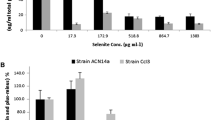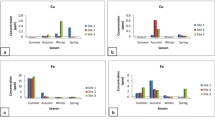Abstract
Growth of three strains of Tetracladium marchalianum was inhibited by Cd-, and, to a lesser extent, by Cu-and Zn-chloride. In the presence of 50 μM Cd(II), all strains increased total thiol and glutathione production to 6, 11, and 21 μmoles · mg−1 dry mass, respectively. Cd(II) also induced the synthesis of one to several compounds reacting with 5,5′-dithio-bis-(2-nitrobenzoic acid). In order to identify buffer-soluble thiolic compounds other than cysteine, γ-EC and γ-ECG (glutathione) were analyzed and confirmed by mass spectrometry. No water soluble sulfides were detectable in any of the culture filtrates, but Cd(II) exposure at a concentration of 50 μM raised sulfide levels in the mycelia of two of the strains between 3 and 7-fold, Cu(II) and Zn(II) had no effect. Energy Dispersive X-ray-analysis (EDX) and Electron Spectrometry-Images (ES-I) of one strain revealed increased levels of Cu and Zn in the cytoplasm and even higher levels in vacuolar precipitates. Zn and Cu are accumulated in the vacuoles as polyphosphates, identified by Electron Energy Loss-Spectrometry (EELS). Cd was found only in the vacuoles.
Similar content being viewed by others
References
Anderson Me (1985) Determination of glutathione and glutathione disulfide in biological samples. — Methods in Enzymology 113: 548–555.
Barlocher F (2005) Freshwater fungal communities. In Dighton J, Oudemans P, White J (eds) The fungal community, 3rd ed, pp. 39–59, Taylor and Francis, CRC Press, Boca Raton.
Berlich M, Menge S, Bruns I, Schmidt J, Schneider B, Krauss G-J (2002) Coumarins give misleading absorbance with Ellman’s reagent suggestive of thiol conjugates. — The Analyst 127: 333–336.
Bruins Mr, Kapils S & Oehme FW (2000) Microbial resistance to metals in the environment. — Ecotoxicology and Environmental Safety 45: 198–207.
Bruns I, Siebert A, Baumbach R, Miersch J, Günther D, Markert B & Krauss G-J (1995) Analysis of heavy metals and sulphur-rich compounds in the water moss Fontinalis antipyretica L.ex Hedw. — Fresenius Journal Analytical Chemistry 353: 101–104.
Bruns I, Sutter K, Menge S, Neumann D, Krauss G-J (2001) Cadmium lets increase the glutathione pool in bryophytes. — Journal Plant Physiology 158: 79–89.
Clemens S (2001) Molecular mechanisms of plant metal tolerance and homeostasis. — Planta 212: 475–486.
Clemens S, Simm C (2003) Schizosaccharomyces pombe as a model for metal homeostasis in plant cells: the phytochelatin-dependent pathway is the main cadmium detoxification mechanism. — New Phytologist 159: 323–330.
Clemens S, Palmgren Mg, Krämer U (2002) A long way ahead: understanding and engineering plant metal accumulation. — Trends in Plant Science 7: 309–315.
Cobbett C, Goldsbrough P (2002) Phytochelatins and metallothioneins: Roles in heavy metal detoxification and homeostasis. — Annual Review of Plant Biology 53: 159–182.
Dameron Ct, Smith Br, Winge Dr (1989) Glutathione-coated cadmium-sulphide crystallites in Candida glabrata. — The Journal of Biological Chemistry 264: 17355–17360.
Ellman Gl (1959) Tissue sulfhydryl groups. — Archives of Biochemistry and Biophysics 82: 70–77.
Gadd Gm (1999) Fungal production of citric acid and oxalic acid: importance in metal speciation, physiology and biochemical processes. — Advances in Microbial Physiology 41: 47–92.
Gadd Gm (2001) Metal transformations. In Gadd GM (ed) Fungi in Bioremediation, pp. 359–382. Cambridge University Press.
Gadd Gm, Sayer Gm (2000) Fungal transformations of metals and metalloids. In Lovley DR (ed) Environmental Microbe-Metal Interactions, pp. 237–256. American Society of Microbiology, Washington.
Gomes D, Fragoso L, Riger C, Panek A, Eleutherio E (2002) Regulation of cadmium uptake by Saccharomyces cerevisiae. — Biochimica Biophysica Acta 1573: 21–25.
Grill El, Winnacker El, Zenk Mh (1991) Phytochelatins. — Methods in Enzymology 205: 333–341.
Hayashi Y, Mutoh N (1994) Cadystin (Phytochelatin) in Fungi. In Winkelmann G, Winge DR (eds) Metal Ions in Fungi, pp. 311–338. Marcel Decker Inc., New York-Basel-Hong Kong.
Isobe M, Uyakul D, Liu K, Goto T (1990) FAB-MS/MS spectrometry in determing the primary structure of g-glutamyl-containing peptides. — Agricultural Biological Chemistry (Tokyo) 54: 1651–1660.
Kikuchi T (1965) Studies on the pathway of sulfide production in a copper-adapted yeast. — Plant Cell Physiology 6: 195–210.
Kneer R, Kutchan TM, Hochberger A, Zenk MH (1992) Saccharomyces cerevisiae and Neurospora crassa contain heavy metal sequestering phytochelatin. — Archives of Microbiology 157: 305–310.
Krauss G, Bärlocher F, Krauss G-J (2003) Effects of pollution on aquatic hyphomycetes. In Tsui CKM, Hyde KD, Ho WM (eds) Freshwater Mycology: A practical approach. — Fungal Diversity Research Series 10: 211–230.
Krauss G, Bärlocher F, Schreck P, Kranich W, Miersch J, Dermietzel J, Wennrich R & Krauss G-J (1998) Aquatic hyphomycetes at extremely polluted sites in the Mansfelder Land area. In Becker PM (ed) Microbiology of polluted aquatic ecosystems pp. 76–83. UFZ-Series, UFZ-Centre for Environmental Research, Leipzig-Halle.
Krauss G, Bärlocher F, Schreck P, Wennrich R, Gläser W, Krauss G-J (2001) Aquatic hyphomycetes occur in hyperpolluted waters in Central Germany. — Nova Hedwigia 72: 419–428.
Krauss G, Sridhar KR, Jung K, Wennrich R, Ehrman J, Bärlocher F (2003) Aquatic hyphomycetes in polluted groundwater habitats of Central Germany. — Microbial Ecology 45: 329–339.
Li ZS, Lu YP, Zhen RG, Szczykpa M, Thiele DJ, Red PA (1997) A new pathway for vacuolar cadmium sequestration in Saccharomyces cerevisiae: YCF1-catalyzed transport of bis(glutathionato)cadmium. — Proceedings of the National Academy of Sciences (USA) 94: 42–47.
Lichtenberger O, Neumann D (1997) Analytical electron microscopy as a powerful tool in plant cell biology: examples using electron energy loss spectroscopy and X-ray analysis. — European Journal of Cell Biology 73: 378–386.
Lin CM, Crawford BS, Kosman DJ (1993a) Distribution of 64Cu in Saccharomyces cerevisiae: Cellular locale and metabolism. — Journal of General Microbiology 139: 1605–1615.
Lin CM, Crawford BS, Kosman DJ (1993b) Distribution of 64Cu in Saccharomyces cerevisiae: Kinetic analysis of partitioning. — Journal of General Microbiology 139: 1617–1626.
Manahan SE (2000) Environmental chemistry, ed., 7th Edition, Lewis Publishers, CRC Press, Boca Raton, USA.
McDiarmid CW, Gaither LA, Eide D (2000) Zinc transporters that regulate vacuolar zinc storage in Saccharomyces cerevisiae. — The European Molecular Biology Organization Journal 19: 2845–2855.
Mehra RK, Mulchandani P, Hunter TC (1994) Role of CdS quantum crystallites in cadmium resistance in Candida glabrata. — Biochemical and Biophysical Research Communications 200: 1193–1200.
Miersch J, Bärlocher F, Bruns I, Krauss G-J (1997) Effect of cadmium, copper, and zinc on growth and thiol content of aquatic hypohomycetes. — Hydrobiologia 346: 77–84.
Miersch J, Tschimedbalshir M, Bärlocher F, Grams Y, Pierau B, Schierhorn A, Krauss G-J (2001) Heavy metals and thiol compounds in Mucor racemosus and Articulospora tetracladia. — Mycological Research 105: 883–889.
Mills AL (2002) Metal requirements and tolerance. In Hurst CJ, Knudsen RL, McInerney MJ, Stetzenbach LD (eds) Manual of environmental microbiology, pp. 456–465. ASM Press, Washington.
Murasugi A, Wada C, Hayashi Y (1983) Occurrence of acid-labile sulfide in cadmium-binding peptide 1 from fission yeast. — Journal of Biochemistry 93: 661–664.
Mutoh N, Hayashi Y (1988) Isolation of mutants of Schizosaccharomyces pombe unable to synthesize cadystin, small cadmium-binding peptides. — Biochemical and Biophysical Research Communications 151: 32–39.
Neumann D, Zur Nieden U, Lichtenberger O, Leopold I (1995) How does Armeria maritima tolerate high heavy metal concentration. — Journal of Plant Physiology 146: 704–717.
Nordberg M (1998) Metallothioneins: historical review and state of knowledge. — Talanta 46: 243–253.
Ortiz DF, Ruiscitti T, McCue KF, Ow DW (1995) Transport of metal binding peptides by HMT1, a fission yeast ABC-type vacuolar membrane protein. — The Journal of Biological Chemistry 270: 4721–4728.
Ow DW, Ortiz DF, Speiser DM, McCue KF (1994) Molecular genetic analysis of cadmium tolerance in Schizosaccharomyces pombe. In Winkelmann G, Winge DR (eds) Metal Ions in Fungi, pp. 339–359. Marcel Dekker Inc., New York-Basel-Hong Kong.
Penninckx MJ (2002) An overview on glutathione in Saccharomyces versus non-conventional yeasts. — Federation European Microbiological Society Yeast Research 2: 295–305.
Plocke DJ, Kägi HR (1992) Spectral characteristics of cadmium-containing phytochelatin complexes isolated from Schizosaccharomyces pombe. — International Journal of Biochemistry 207: 201–205.
Prasad MNV (ed) (2001) Metals in the environment — Analysis of biodiversity. Marcel Dekker Inc., New York-Basel-Hong Kong.
Rao VSKVR, Wilson CH, Mohan PM (1997) Zinc resistance in Neurospora crassa. — BioMetals 147:147–156.
Rother M (2002) Zur Bildung Schwermetall-bindender Proteine in Heliscus lugdunensis Saccardo et Therry unter Cadmium-Streß. Diplomarbeit, Universität Halle-Wittenberg.
Seregin IV, Ivanov VB (2001) Physiological aspects of cadmium and lead toxic effects on higher plants. — Russian Journal of Plant Physiology 48: 523–544.
Shen J, Hsu CM, Kang B-K, Rosen BP, Bhattacharjee H (2003) The Saccharomyces cerevisiae Arr4p is involved in metal and heat tolerance. — BioMetals 16: 369–378.
Trüper HG, Schlegel HG (1964) Sulphur metabolism in Thiorhodaceae. I. Quantitative measurements on growing cells of Chromatium okenii. — Antonie van Leeuwenhoek 30: 225–238.
Turnau K, Kottke I, Dexheimer J (1996) Toxic element filtering in Rhizopogon roseolus/Pinus sylvestris mycorrhizas collected from calamine dumps. — Mycological Research 100: 16–22.
Van Ho A, McVey Ward D, Kaplan J (2002) Transition metal transport in yeast. — Annual Review Microbiology 56: 237–261.
Vepachedu SKVRR, Akthar N, Mohan PM (1997) Isolation of cadmium tolerant Curvularia sp. from polluted effluents. — Current Science 73: 453–455.
Winge DR, Sewell AK, Yu W, Thorvaldsen JL & Farell H (1998) Metal ion stress in yeast. In Silver S, Walden W (eds) Metal ions in gene regulation,pp. 279–315. Chapman & Hall, New York.
Author information
Authors and Affiliations
Corresponding author
Rights and permissions
About this article
Cite this article
Miersch, J., Neumann, D., Menge, S. et al. Heavy metals and thiol pool in three strains of Tetracladium marchalianum . Mycol Progress 4, 185–194 (2005). https://doi.org/10.1007/s11557-006-0122-8
Accepted:
Issue Date:
DOI: https://doi.org/10.1007/s11557-006-0122-8




